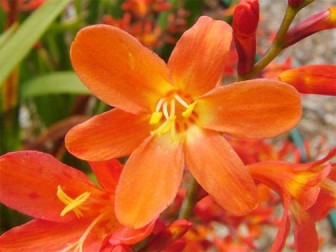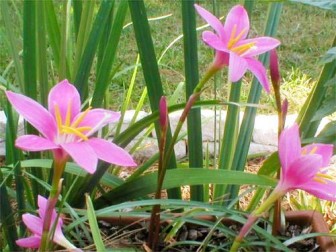Most gardeners will know that the bulb is a development in plants which is designed to assist them survive long periods of dormancy that occur in dry places on earth. It gives food to the emerging shoots and roots once the cold winter period or long dry period is over, and growth can begin again. It is a feature of temperate zones and also the tropical zones which have very long dry periods.
 However, it is a fact that the nearer one gets to the equatorial tropics (the wet parts) the less plants need to make provision for a long dry period in their lives. They have no need because in the tropics you get growth occurring throughout the year.
However, it is a fact that the nearer one gets to the equatorial tropics (the wet parts) the less plants need to make provision for a long dry period in their lives. They have no need because in the tropics you get growth occurring throughout the year.
Today I want to talk to you about two plants which grow from bulbs, and which are found in what one might term the sub-tropics. In other words those parts which could quite easily have extended dry periods. They are the Wind flower found in (the warmer parts of) the Americas and the West Indies, and the Montbretia from southern Africa. Both these areas of the world can have long periods of dry weather and the need for plants to develop a bulb is understandable.

In Guyana, and throughout the West Indies one is treated to fleeting displays of the Wind flower, which also known by attractive names such as the Zephyr lily, the tropical crocus, and the Barbados snowdrop. Zephyranthes (that is its Latin name) comes in a variety of colours. The Barbados snowdrop, as its name suggests, is white, and is rarely seen in that island now and hardly in Guyana either. The pink variety is also less well known, but can be seen in Guyana occasionally.
None of the Wind flowers get more than a couple of inches tall, and they generally all come into flower at the end of the ‘dry,’ just a few days after the first rains. I have never wanted to grow them in pots preferring to see them growing naturally along the roadside or central reservations. I have gardening friends in Barbados who have tried to grow them in pots but they have not had what you might describe as spectacular success. The Zephyr flower is found throughout the West Indies, and many parts of the Southern USA and Central and South America. That is not to say that it is common. It is not, but it is one of the little gems that make us glad to be alive.

I have recently come across an old favourite of mine called the Montbretia, which is a kind of upper class iris if you like, and is now lumped under the general name of Crocosmia. I first came across this plant in the Birmingham Botanic Gardens in England, and shortly afterwards I saw it growing naturally fairly high up in the Drakensberg mountain range in South Africa. Like so many plants it does not need to have a rich soil. There is already enough food in the bulb to support the first year’s flowers. After flowering of course one must try and feed the leaves as they help to build up the bulb (it’s a corm really) for the next year’s display. The flowers are super for cutting for the table, and for use in displays, although one or two forms are a bit too one sided in my view but they do last. The Crocosmia forms very large clumps if left alone, and they divide very easily when the plant is resting. The corms are easy to store in a dry shed or in dry sand. Once they are established in a herbaceous border leave them alone.
Until next week may your God go with you wherever you may be.




